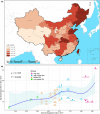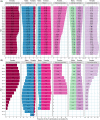Changes in the disease burden of breast cancer along with attributable risk factors in China from 1990 to 2019 and its projections: An analysis of the global burden of disease study 2019
- PMID: 35785526
- PMCID: PMC9883426
- DOI: 10.1002/cam4.5006
Changes in the disease burden of breast cancer along with attributable risk factors in China from 1990 to 2019 and its projections: An analysis of the global burden of disease study 2019
Abstract
Background: To investigate the secular trends in breast cancer burden with attributable risk factors, and make projections over time, which would contribute to the control and prevention of breast cancer.
Methods: We extracted detailed data on breast cancer incident cases and age-standardized incidence rate (ASIR), deaths and age-standardized mortality rate (ASMR), disability-adjusted life-years (DALYs), and age-standardized DALYs rate (ASDR), as well as the attributable risk factors in China from the Global Burden of Diseases Study 2019. The estimated annual percentage change (EAPC) was calculated to quantify the changing trends. The national DALYs attributable to Socio-demographic Index (SDI) values were also presented. Projections to 2030 were estimated using the Bayesian age-period-cohort model.
Results: From 1990 to 2019, the number of breast cancer incident cases increased fourfold to 375,484, with deaths and DALYs over doubling to 96.306 and 2,957,454, respectively. The ASIR (EAPC = 2.84; 95% CI, 2.74-2.95) and ASMR (EAPC = 0.06; 95% CI, 0.00-0.12) increased, while the ASDR decreased with the EAPC of -0.13 (95% CI, -0.19 to -0.06) at the same period. The ASDR varied across provincial regions, which appeared to be in a wave-like upcurve with SDI values increasing. High body mass index became the first contribution to breast cancer DALYs for females in 2019, and alcohol use for males. Breast Cancer incident cases and deaths would increase to 587.7 and 125.6 thousand in 2030, of which there will be 577.1 and 122.7 thousand for females, and 10.6 and 2.9 thousand for males, respectively.
Conclusion: Breast cancer remains a major public health problem in China. The absolute burden has been increasing over time, and varied across sex and regions. To control the potential risk factors and develop specific strategies will help to reduce the disease burden.
Keywords: breast cancer; disease burden; risk factor; spatiotemporal trend.
© 2022 The Authors. Cancer Medicine published by John Wiley & Sons Ltd.
Conflict of interest statement
The authors have no relevant financial or non‐financial interests to disclose.
Figures





Similar articles
-
Global, regional, and national burden of chronic kidney disease attributable to high sodium intake from 1990 to 2019.Front Nutr. 2023 Mar 2;10:1078371. doi: 10.3389/fnut.2023.1078371. eCollection 2023. Front Nutr. 2023. PMID: 36937353 Free PMC article.
-
The Burden of Gastric Cancer Attributable to High Sodium Intake: A Longitudinal Study from 1990 to 2019 in China.Nutrients. 2023 Dec 13;15(24):5088. doi: 10.3390/nu15245088. Nutrients. 2023. PMID: 38140347 Free PMC article.
-
The burden of colorectal cancer attributable to diet low in whole grains from 1990 to 2021: a global, regional and national analysis.Front Nutr. 2025 Apr 9;12:1527522. doi: 10.3389/fnut.2025.1527522. eCollection 2025. Front Nutr. 2025. PMID: 40271437 Free PMC article.
-
Evolving landscape of colorectal cancer: Global and regional burden, risk factor dynamics, and future scenarios (the Global Burden of Disease 1990-2050).Ageing Res Rev. 2025 Feb;104:102666. doi: 10.1016/j.arr.2025.102666. Epub 2025 Jan 18. Ageing Res Rev. 2025. PMID: 39828028 Review.
-
A comparative study of incidence, mortality and disability adjusted life years (DALYs) for leading cancers in BRICS countries.Ecancermedicalscience. 2024 Sep 19;18:1773. doi: 10.3332/ecancer.2024.1773. eCollection 2024. Ecancermedicalscience. 2024. PMID: 39430096 Free PMC article. Review.
Cited by
-
Diagnostic value of mammography density of breast masses by using deep learning.Front Oncol. 2023 Jun 2;13:1110657. doi: 10.3389/fonc.2023.1110657. eCollection 2023. Front Oncol. 2023. PMID: 37333830 Free PMC article.
-
Diagnostic value of circulating miR-155 for breast cancer: a meta-analysis.Front Oncol. 2024 Mar 25;14:1374674. doi: 10.3389/fonc.2024.1374674. eCollection 2024. Front Oncol. 2024. PMID: 38590648 Free PMC article.
-
Global estimates of rehabilitation needs and disease burden in tracheal, bronchus, and lung cancer from 1990 to 2019 and projections to 2045 based on the global burden of disease study 2019.Front Oncol. 2023 Jun 29;13:1152209. doi: 10.3389/fonc.2023.1152209. eCollection 2023. Front Oncol. 2023. PMID: 37456232 Free PMC article.
-
Value of altered methylation patterns of genes RANBP3, LCP2 and GRAP2 in cfDNA in breast cancer diagnosis.J Med Biochem. 2024 Jun 15;43(4):387-396. doi: 10.5937/jomb0-47507. J Med Biochem. 2024. PMID: 39139156 Free PMC article.
-
A cross-sectional study of serum lipids, body mass index and age relationships with breast cancer risk.World J Surg Oncol. 2025 Apr 26;23(1):168. doi: 10.1186/s12957-025-03817-y. World J Surg Oncol. 2025. PMID: 40287713 Free PMC article.
References
-
- Global Cancer Observatory: Cancer Today. https://gco.iarc.fr/today/home. Accessed Oct. 11, 2021.
MeSH terms
LinkOut - more resources
Full Text Sources
Medical

